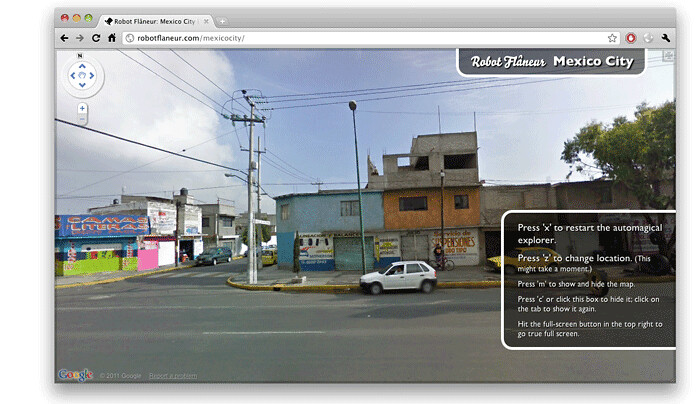
[tl;dr—I made a thing: Robot Flâneur.]
“The crowd is his element, as the air is that of birds and water of fishes. His passion and his profession are to become one flesh with the crowd. For the perfect flâneur, for the passionate spectator, it is an immense joy to set up house in the heart of the multitude, amid the ebb and flow of movement, in the midst of the fugitive and the infinite. To be away from home and yet to feel oneself everywhere at home; to see the world, to be at the centre of the world, and yet to remain hidden from the world—impartial natures which the tongue can but clumsily define. The spectator is a prince who everywhere rejoices in his incognito. The lover of life makes the whole world his family, just like the lover of the fair sex who builds up his family from all the beautiful women that he has ever found, or that are or are not—to be found; or the lover of pictures who lives in a magical society of dreams painted on canvas. Thus the lover of universal life enters into the crowd as though it were an immense reservoir of electrical energy. Or we might liken him to a mirror as vast as the crowd itself; or to a kaleidoscope gifted with consciousness, responding to each one of its movements and reproducing the multiplicity of life and the flickering grace of all the elements of life… any man who can yet be bored in the heart of the multitude is blockhead! A blockhead! and I despise him!”—Charles Baudelaire
“Social misery has inspired the comfortably-off with the urge to take pictures, the gentlest of predations, in order to document a hidden reality, that is, a reality hidden from them. Gazing on other people’s reality with curiosity, with detachment, with professionalism, the ubiquitous photographer operates as if that activity transcends class interests, as if its perspective is universal. In fact, photography first comes into its own as an extension of the eye of the middle-class flâneur, whose sensibility was so accurately charted by Baudelaire. The photographer is an armed version of the solitary walker reconnoitering, stalking, cruising the urban inferno, the voyeuristic stroller who discovers the city as a landscape of voluptuous extremes… The flâneur is not attracted to the city’s official realities but to its dark seamy corners, the neglected populations—an unofficial reality behind the façade of bourgeois life that the photographer ‘apprehends,’ as a detective apprehends a criminal.”—Susan Sontag
“Google Street View is both the view from the machine (from the car, the Ballardian view-of-our-times) and the view of the machine (the way the machine sees). Overlayed with data augmentation, from a non-human-natural perspective (the roof of the car), slightly lensed (fish-eyed), wholly networked.”—Me
“… ‘sensor-vernacular’. It’s an aesthetic born of the grain of seeing/computation. Of computer-vision, of 3d-printing; of optimised, algorithmic sensor sweeps and compression artefacts. Of LIDAR and laser-speckle. Of the gaze of another nature on ours… the robot-readable world.”—Matt Jones
I made a thing over the wet weekend: Robot Flâneur. Enjoy.
[…] Robot Flâneur“Google Street View is both the view from the machine (from the car, the Ballardian view-of-our-times) and the view of the machine (the way the machine sees). Overlayed with data augmentation, from a non-human-natural perspective (the roof of the car), slightly lensed (fish-eyed), wholly networked.”(tags:cities digital net viewing social ) […]
Pingback by Warren Ellis » Bookmarks for 2011-06-13 — June 14, 2011 @ 2:01 am